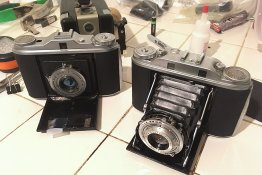Thanks for taking the time to post your experiences. I hve an Agfa Isolette III that has the frozen lens and rangefinder, like yours, and since mine is in minty condition with a good bellows, I've been kinda slow doing anything with it. Alll I've done so far is take the lens loose from the front standard. Just so I understand what you did -- you used heat to free up the III's lens, then you flushed it with white gas, correct? I dunno if I want to mess with white gas. I'm thinking that, after freeing things up, I can flush it with naphtha, then lube it and hopefully be done with its maintenance for a couple of decades.
What temperature setting did you set your oven to for this?
I removed the focus ring (three screws, don't take them all the way out), and unscrewed the lens group, which was stuck together.
I set the oven to 200°f, and put the lens group in a small metal pie plate and put it in the oven. Once the oven got up to temp, I turned it off and let the group sit in there for 10 minutes or so. Of the 2 cameras, one of them unscrewed right away with leather work gloves. The other one still wouldn't budge. I wrapped the focus-end in several layers of blue tape, and also the shutter threads, and stuck a 3/4" pipe clamp on each end and re-heated - once it warmed up, I had to tighten the clamps and then heated some more. They gave me enough grip to get it open. But - I think the clamps made something a hair out-of-round, I can feel it when I focus, but it works fine. So maybe heat and patience. Heat (the soldering iron) worked on the RF focus knob as well, when no solvent would do it. if you have a III, there's a mirror on a spring in the RF box which pivots on a post - you want to remove the mirror and clean and lube the pivot. Mine now focuses like butter.
I removed the shutter from the bellows (spanner wrench required). There's a half-circle screw that blocks a really thin shim from turning - the shim is the nut for the shutter cover. If you don't know how to take the whole shutter apart,
don't work the shutter with the cover off! The main arm-thing will leap out and you'll have to suss out how it interconnects with the other components. You can lift the cover off, and then you can soak it in a dish of solvent and then really flush the shutter (I used a small squirt bottle to really hose it down), put the cover back on and exercise it (there are spots you can hold the cover down and keep your fingers clear of moving parts that stick out of the cover), "rinse and repeat". Then let it dry.
I had plenty of white gas around - it's used in camp stoves and lanterns, and it's no more dangerous than lighter fluid I'd imagine, as far as your skin goes (wear some rubber gloves with either, at the least you'll have some really dry skin with either product!) The white gas is designed to really burn when vaporized, so I didn't fool around with it indoors in my small repair area (with a hot water heater and pilot light nearby). Outdoors, no issue. I unstuck a Mamiya RB shutter with it and it worked great - dropped the shutter in a dish of white gas, turned my back to go wait, and heard "CLICK" - the shutter had opened almost instantly. Doesn't mess with any painted parts in my experience.
When I reassembled, I used a tiny bit of brake grease to lube the focus threads - like a couple swiped with a toothpick, and worked it around with a small rag. I used a link I'd found to collimate the lens - you set the lens to infinity, tape or mylar on the film plane with a sharpie cross in the middle and a light source behind. Then aim another camera right into the Isolette lens, set to infinity, almost touching glass-to-glass. Look through the 2nd camera's VF and adjust the focus on the isolette - when the mark on the tape becomes sharp, it's collimated and you install and tighten the focus ring (I used an RB for the big focusing screen and it made it easy to adjust the Isolette while looking down into the WLF).
I also put tiny drops of lube on the shutter cocking linkage - I used brass instrument valve oil and wiped it up after getting it in the pivot points - they're just stamped steel and rivets.
The Apotar lens in mine turns out to be a nice performer for B&W anyway, it's a very cool little camera and the RF is nice - not linked to the lens but better than guessing.









 I'd check for a 6x9 with color head and maybe a friend will give a 4"x5" b/w too. We'll see how it goes....
I'd check for a 6x9 with color head and maybe a friend will give a 4"x5" b/w too. We'll see how it goes.... Isolette III
Isolette III



